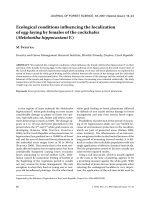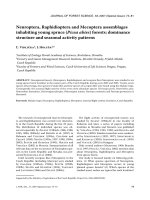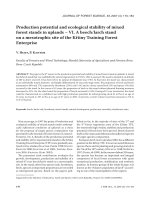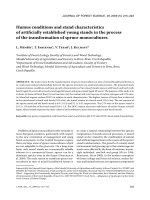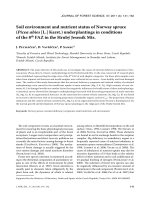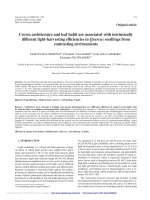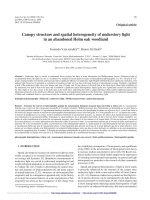Báo cáo lâm nghiệp: " Humus conditions and stand characteristics of artificially established young stands in the process of the transformation of spruce monocultures" pdf
Bạn đang xem bản rút gọn của tài liệu. Xem và tải ngay bản đầy đủ của tài liệu tại đây (352.05 KB, 9 trang )
J. FOR. SCI., 55, 2009 (5): 215–223 215
JOURNAL OF FOREST SCIENCE, 55, 2009 (5): 215–223
Problems of spruce monocultures refer seriously to
more European countries, particularly with respect
to the new orientation of management and using
forest ecosystems. In the Central European region,
there are large areas of spruce monocultures which
are not adaptable to the given site. On a long-term
basis, only mixed stands are economically reliable
whereas in a commercial forest, spruce can be a
dominant species even in the future (S et
al. 2004). e main reason to transform spruce mo-
nocultures at sites of mixed broadleaved forests is
to create a natural relationship between the species
composition of stands and soil processes. A mixed
stand can be created by the combination of natural
and artificial regeneration in the course of the spruce
stand transformation. e growth of a stand, stand
environment and growing up to the rotation age are
much more affected by the form of a mixture, in prin-
ciple individual, row/belt and group (O 1994;
B, H 2003). In the modern conception
of forest ecology and forest soil science, surface hu-
mus and humus horizons are important components
Supported by the Internal Grant Agency of the Mendel University of Agriculture and Forestry in Brno, Projects No. 32/2007 and
09/2009, the Ministry of Education, Youth and Sports of the Czech Republic, Research Plan No. MSM 6215648902 Forest and
Wood – Supporting the Functionally Integrated Forestry and Using the Wood as a Renewable Raw Material, and the Ministry
of Environment of the Czech Republic, Project No. MZP SP/2d1/93/07 Czech Terra – Adaptation of Landscape Carbon Sinks
in the Context of Global Change.
Humus conditions and stand characteristics
of artificially established young stands in the process
of the transformation of spruce monocultures
L. M
1
, T. F
1
, V. T
2
, J. K
1
1
Institute of Forest Ecology, Faculty of Forestry and Wood Technology,
Mendel University of Agriculture and Forestry in Brno, Brno, Czech Republic
2
Department of Forest Establishment and Silviculture, Faculty of Forestry
and Wood Technology, Mendel University of Agriculture and Forestry in Brno, Brno,
Czech Republic
ABSTRACT: e main reason for the transformation of spruce monocultures at sites of mixed broadleaved forests is
to create more natural relationships between the species structure of a stand and soil processes. e presented study
compares humus conditions and basic growth characteristics of two mixed stands (spruce with beech and larch with
beech) aged 25 years with a beech stand (aged 40 years) and spruce stand (aged 30 years). e purpose of the study is to
evaluate (i) forms of forest floor, (ii) soil reaction, (iii) the content and total reserves of carbon, nitrogen and C/N ratio,
(iv) dissolved organic carbon (DOC) in relation to stand characteristics. e highest reserve of forest floor is detected
in the mixed stand of larch with beech (52.6 t/ha), the lowest reserve in a beech stand (21.0 t/ha). e soil reaction of
the spruce stand and the beech stand is 4.0 (± 0.3) and 5.1 (± 0.3), respectively. e C/N ratio of the spruce stand is
23.5 (± 1.8) and that of the beech stand 18.8 ± 2.9. e DOC content decreases with layers of surface humus towards
depth. Mixed stands represent by their values of soil conditions a mean between spruce and beech stands.
Keywords: tree species composition; soil; forest floor reserves and forms; pH; C/N ratio; DOC; forest stand characteristics
216 J. FOR. SCI., 55, 2009 (5): 215–223
of a forest ecosystem from the point of view of the
element cycle preservation in forest ecosystems and
maintaining their ecological stability. e condition
and form of humus in forest management is one of
key factors affecting the condition and growth of
stands. In the course of the past century, this fact was
mentioned by prominent specialists in the field of
forest pedology, e.g. N (1928), M and K
(1948), P (1964), Š (1977, 1978). Humus
represents a place of the main accumulation of carbon
in the majority of terrestrial ecosystems and because
it remains there unoxidated for centuries it becomes
an important long-term reservoir of carbon in an
ecosystem (W, R 1998). Forest floor is
very important for forest soils affecting a number of
their properties. It is the regulator of runoff of rainfall
water in watersheds, decreases the hazard of floods in
piedmont and lowland regions, intercepts consider-
able amounts of rainfall water penetrating through
crowns of stands and releases the water into underly-
ing soil layers to increase groundwater reserves and
decides on runoff, evaporation and groundwater flow
(K, Š 2008). It also controls temperature
conditions reducing temperature fluctuations in soils
between day and night (P 1964).
Last but not least, it serves as the source of energy
for soil organisms (S 2003). e aim of the
paper is to evaluate humus conditions (reserves and
forms of forest floor, soil reaction, the content and
total reserves of carbon, nitrogen and C/N ratio,
dissolved organic carbon) and basic growth charac-
teristics of two mixed stands (spruce with beech and
larch with beech) aged 25 years with a pure beech
stand (aged 40 years) and pure spruce stand (aged
30 years) in the Drahanská vrchovina Upland.
MATERIAL AND METHODS
Site and stand descriptions
e study compares humus conditions and basic
growth characteristics of two mixed stands estab-
lished by planting at a constant spacing of 2 × 2 m
(spruce with beech in the row ratio spruce1:beech1,
beech proportion 30% and larch with beech in the
row ratio larch1:beech2, beech proportion 40%) at
the age of 25 years with a pure beech stand (40 years)
established by seeding and spruce (30 years) estab-
lished by planting. e study is carried out in the
Rájec-Němčice field research station of the Institute
of Forest Ecology, Mendel University of Agriculture
and Forestry in Brno, about 3 km west of the village
of Němčice (49°29'31''N and 16°43'30''E). Modal
oligotrophic Cambisol (N et al. 2001) is the
soil type of the area. e research plots are situated at
an altitude of 600–660 m corresponding to a slightly
warm climatic region (Q 1971). e mean
annual air temperature of the area is 6.5°C and the
mean annual precipitation 717 mm (H 2002).
The Forest Management Institute (Brandýs nad
Labem) has classified potential growth conditions
as Abieto-Fagetum mesotrophicum with Oxalis ace-
tosella, i.e. the locality is situated at the upper limit
of the beech forest vegetation zone. Brief character-
istics of the research plots are given in Table 1.
Soil sampling and analyses procedure
e diameter at breast height (dbh) and height (h)
of all trees inevitable for the construction of a height
diagram were determined, i.e. at the most five trees
in every diameter class.
Samplings of forest floor for the reserve determina-
tion and subsequent analyses were carried out always
at the end of the growing season, in autumn, after
the leaf fall in 2004–2006. Particular samples were
taken by a standard method using the metal frame
of a known area (0.1 m
2
). In each of the four stands,
10 samplings of particular layers (L, F and H) were
carried out. After transfer to the laboratory, the sam-
ples were dried up at 60°C to a constant weight in an
oven, weighed and mean dry weight was calculated
and reserves of forest floor per ha were calculated
from it. Samples of the organomineral horizon (Ah)
Table 1. Short characteristics of experimental forest stands
Species composition
Age
N/ha
Soil Forest typology
Spruce 100
30
–
Modal oligotrophic
Cambisol*
Cambisols (CM)**
5S1 – Abieto-Fagetum
mesotrophicum with Oxalis
acetosella***
Spruce 70, beech 30
25
1,630 (spruce 1,145, beech 485)
Larch 60, beech 40
25
1,110 (larch 670, beech 440)
Beech 100
40
2,330
*Soil taxonomy by N et al. (2001), **WRB, ***taxonomy by FMI (Forest Management Institute, Brandýs nad Labem)
J. FOR. SCI., 55, 2009 (5): 215–223 217
were taken in all three stands in autumn 2005 and
2006. On five places in each of the variants, pedologi-
cal ditches were dug and by means of a shovel and
knife or a soil probe, Ah horizon was taken from
them. Horizons from each repetition were taken
separately to a paper or plastic bag.
Values of active and exchangeable soil acidity were
determined by a potentiometer method (Z et
al. 1997) using a digital pH-meter OP-208/1 (Radel-
kis Budapest, Hungary). Fundamental nutrients, i.e.
carbon and nitrogen, were determined from sam-
ples devoid of coarse particles after fine grinding
or comminution on a LECO TruSpec analyzer (MI
USA) (Z et al. 1997). Dissolved organic carbon
(DOC) of soil samples was determined by an adapted
method according to R et al. (1999). en,
the content of DOC was determined using Shimadzu
TOC-V
CSH/CSN
analyzer (Shimadzu Corporation,
Japan). Mensurational characteristics of stands were
determined by standard procedures.
Processing the statistical values
Statistical analyses were carried out in the Sta-
tistics Program (Stat-Soft Inc., Tulsa, USA). Sin-
gle-factor analysis ANOVA was used and for the
Table 2. Stand characteristics and statistical differences in forest floor properties
Stand characteristics Spruce Spruce with beech Larch with beech Beech
d
1.3
(cm)/SD
Spruce – 13.6/4.8 – –
Larch – – 19.5/5.6 –
Beech – 5.5/3.6 6.7/3.6 12.6/5.1
h (m)
Spruce – 12.3 – –
Larch – – 14.9 –
Beech – 8.5 9.3 15.5
G (m
2
/ha) – 19.9 23.7 34.0
Spruce – 18.2 – –
Larch – – 21.7 –
Beech – 1.8 2.0 34.0
Stock of forest floor (horizons L + F + H)
Spruce X NS
** **
Spruce with beech NS X
** **
Larch with beech
** **
X
**
Beech
** ** **
X
Stock of carbon (nitrogen) in forest floor (horizons L + F + H)
Spruce X * (NS) NS (NS) * (NS)
Spruce with beech * (NS) X * (*) NS (NS)
Larch with beech NS (NS) * (*) X * (*)
Beech stand * (NS) NS (NS) * (*) X
pH (H
2
O), (pH KCl) in forest floor (horizons L + F + H)
Spruce X ** (NS) NS (NS) ** (NS)
Spruce with beech ** (NS) X NS (NS) NS (NS)
Larch with beech NS (NS) NS (NS) X NS (NS)
Beech ** (**) NS (NS) NS (NS) X
*Statistically significant differences (α < 0.05), **high
statistically significant differences (α < 0.01), NS – not significant
218 J. FOR. SCI., 55, 2009 (5): 215–223
detection of differences between groups, Tukey test
was applied. Significance was tested on the level of
α = 0.05. Moreover, descriptive statistics were used
(mean value, standard deviation) in mensurational
characteristics.
RESULTS AND DISCUSSION
Stand characteristics
e mean dbh and stand height (Table 2) of spruce
and larch are rather higher than it would correspond
to the site class of matures stands. e diameter
range of trees in mixed variants is very broad starting
with very low values with respect to the stand age of
25 years. us, the stands are heavily neglected from
the aspect of forest management. At the same time,
however, they show how beech is able to survive
under a fully closed stand of larch and spruce and
what are existence limits of the most disadvantaged
trees. Even the variant of the beech stand shows a
very broad diameter range and it is evident that trees
of the largest diameter have to be removed for the
formation and development of a future quality stand.
It is also evident from the high value of a basal area
(34 m
2
/ha). Under given natural conditions, beech
would be a basic species in close-to-nature stands.
In a commercial forest, beech is grown even in un-
mixed productive stands. In spruce management,
which is economically effective also in the beech
forest zone, it serves particularly as a soil-improving
and reinforcing species in the interest of sustainable
development. In its favourable position to spruce, it
can provide rather large volume of relatively valuable
wood. Nevertheless, it is doubtful if it can achieve it
as a row mixture. e high production potential of
individually mixed larch/beech stands is known and
exactly documented from the Drahanská vrchovina
Upland (K 1990; H, K 2007). Such
a mixture is suitable for reinforcing belts in spruce
stands.
Forest floor reserve
The forest floor reserve (Fig. 1) ranged from 22.0 to
52.6 t/ha and the depth of horizons (L, F, H) ranged
from 3 to 8 cm. The forest floor stock in horizon L
was determined from 4.9 to 5.3 t/ha. Statistically
significant differences at the level of significance
(α = 0.05) were not found. Accumulation of humus
in F horizon in an unmixed beech stand (8.4 t/ha)
was statistically on the level of significance (α < 0.01)
markedly lower than in a spruce stand and mixed
stands (15.0–17.2 t/ha). Accumulation of humus in
H horizon in a stand of larch with beech (32.0 t/ha)
was statistically markedly higher at a level of
significance (α < 0.01) than in an unmixed stand
of spruce, beech and mixed stand of spruce with
beech. The highest accumulation of forest floor
was in the stand of larch with beech (52.6 t/ha). The
lowest accumulation was found in the unmixed
stand of beech (22.0 t/ha). Accumulation in the
unmixed spruce stand and mixed stand of spruce
with beech was 36.8 and 33.0 t/ha, respectively.
The survey of statistically significant differences
in the total reserve in forest floor between stands
is given in Table 2. The forest floor reserve is also
related to the form of humus (E 1999). Hu-
mus forms were as follows: moder in the unmixed
spruce stand and mixed stands, mull-moder in the
unmixed beech stand (according to N et
al. 2001). The high accumulation of humus in H
horizon in the mixed stand of larch with beech is
evidently given by a fact that part of the reserve
comes from a former mature spruce stand and de-
composition has not occurred yet. Thus, decrease
in the accumulation of humus did not take place
in this horizon. Low accumulation in H horizon in
Fig. 1. Reserves of forest floor in different
experimental stands
22.0
52.6
33.0
36.8
0
10
20
30
40
50
60
Spruce Spruce with
beech
Larch with
beech
Beech
(t/ha)
L F H L+F+H
22.0
52.6
33.0
36.8
0
10
20
30
40
50
60
Spruce Spruce with
beech
Larch with
beech
Beech
(t/ha)
L F H L+F+H
22.0
52.6
33.0
36.8
0
10
20
30
40
50
60
Spruce Spruce with
beech
Larch with
beech
Beech
(t/ha)
L F H L+F+H
22.0
52.6
33.0
36.8
0
10
20
30
40
50
60
Spruce Spruce with
beech
Larch with
beech
Beech
(t/ha)
L F H L+F+H
22.0
52.6
33.0
36.8
0
10
20
30
40
50
60
Spruce Spruce with
beech
Larch with
beech
Beech
(t/ha)
L F H L+F+H
J. FOR. SCI., 55, 2009 (5): 215–223 219
the unmixed beech stand, which is ten to fifteen
years older than other stands, indicates faster de-
composition and mineralization of organic matter
and better cycling of nutrients. It also corresponds
to the higher content of dissolved organic carbon
(DOC) and lower C/N ratio (see Figs. 6 and 7 in
particular horizons of forest floor). On the basis
of determined results we can conclude that the
reserve of the mixed stand of spruce with beech
approaches more the unmixed spruce stand than
the unmixed beech stand. We can state that the
proportion of beech amounting to 30% in a mixed
stand shows positive soil-improving effect.
Soil reaction
Both actual (in H
2
O) and exchangeable (in nKCl) pH
was determined. In the surface humus, values of both
actual and exchangeable pH decrease with increasing
depth (Figs. 2 and 3) in all stands and the lowest values
were determined in the H layer. e lowest values in
forest floor in the H horizon (3.5 and 3.7) as well as in
the organomineral horizon A
h
(2.7 and 2.7) were deter-
mined in a pure spruce stand where the actual soil re-
action could be specified as heavily acid to very heavily
acid. e highest pH values in H horizon were found in
a beech stand, soil reaction (in H
2
O) is moderately up
to heavily acid (4.7 and 4.1 forest floor, 4.1 and 3.3 A
h
horizon). In L and F horizons, statistically significant
differences in active and exchangeable pH occurred on
the level of significance (α < 0.01) between the unmixed
spruce monoculture and mixed stands and unmixed
beech monoculture. In H horizon in active pH, statisti-
cally significant differences on the level of significance
(α < 0.05) occurred between the unmixed spruce stand
and mixed stand of spruce with beech, between the
unmixed spruce and beech stand, mixed stand of larch
with beech and unmixed beech stand. In exchangeable
pH on the level of significance (α < 0.01), statistically
significant differences occurred between the unmixed
beech stand and unmixed spruce stand, mixed stand of
larch with beech. On the level of significance (α < 0.05)
between the unmixed beech stand and mixed stand
of spruce with beech. Statistically significant differ-
ences of active and exchangeable pH in forest floor
(mean values for L, F and H layers) are given in Ta-
ble 2.
M and K (1948) mention pH values for
beech humus within the limits 5.3–6.6 and for spruce
3.7–4.5. Similarly, Š (1978) gives pH values for the
leaf litter within the limits 5.0–6.5 and for conifers
4.0–5.0. In the event that we evaluate the mixed stand
of spruce with beech and the mixed stand of larch
3.7
4.0
4.3
4.3
5.4
5.1
5.4
4.6
5.1
4.7
5.0
4.0
4.7
4.0
4.1
3.5
3.0
4.0
5.0
6.0
Spruce Spruce with
beech
Larch with
beech
Beech
pH (H
2
O)
L F H Ah
Fig. 2. Distribution of pH
H
2
O
in layers of
forest floor and organomineral horizon
in different experimental stands
Fig. 3. Distribution of pH
KCl
in layers of
forest floor and organomineral horizon
in different experimental stands
2.7
3.1
3.3
3.2
4.7
4.3
4.5
3.3
4.1
3.2
2.7
3.3
2.0
3.0
4.0
5.0
6.0
Spruce Spruce with
beech
Larch with
beech
Beech
pH (KCl)
L F H Ah
4.2
4.8
4.7
4.9
220 J. FOR. SCI., 55, 2009 (5): 215–223
with beech of various proportions we can conclude
that beech in proportion from 30 to 40% positively
improves pH values. It applies to larch, which rather
worsens soil reaction although it occurs in a variant
with beech. Exchangeable soil reaction shows a similar
course as active reaction. Relatively small differences
between active and exchangeable pH values show
evidence of the relative sufficiency of basic cations in
the uppermost layers of soil (U 1989). As for the
division of soils according to values of soil reaction into
particular buffer zones, soil in a spruce stand and in
mixed stands is included into an exchangeable zone
(aluminium zone of buffering). In the beech stand, it is
possible to classify soil according to pH values to a bor-
derline of the buffer zone of the cation exchangeable
capacity where the increased input of hydrogen ions is
compensated for by basic cations. us, compensation
of the increased input of hydrogen ions occurs there
through the creation of Al
3+
ions from polymeric Al
compounds (U 1989; K 1997).
Carbon, nitrogen, C/N ratio
In 2004–2006, the content of total carbon ranged
in particular stands within the limits 43.7–49.3% for
L horizon, 27.5–41.1% for F horizon and 15.8–23.0%
for H horizon. In the organomineral horizon A
h
,
the content of total carbon ranged within the limits
5.0–6.8%. In 2004–2006, the content of total nitro-
gen ranged within the limits 1.1–1.3% for L horizon,
1.2–1.6% for F horizon and 0.7–1.0% for H horizon.
In the organomineral horizon A
h
, the content of total
carbon ranged within the limits 0.2–0.3%. e largest
reserve of carbon (Fig. 4) in forest floor occurs in
the spruce and in the larch/beech stands –12.9 t/ha
and 12.8 t/ha, respectively (488 kg/ha and 532 kg/ha
nitrogen, respectively, Fig. 5). Statistically significant
differences were detected in carbon reserve in for-
est floor between mixed stands and a pure spruce
and beech monoculture at the level of significance
α = 0.05; in nitrogen only between mixed stands and
a pure beech stand (Table 2). e C/N ratio in forest
floor in L and F horizons is similar in all four plots
ranging within the limits 37–42 for L horizon and
24–25 for F horizon. e lowest C/N ratio occurs
in forest floor in H horizon (Fig. 6) in a pure beech
stand (19), the highest C/N ratio is in the spruce
stand (24). Mixed stands show identical C/N ratio
(22). e C/N ratio in the organomineral horizon
A
h
is lowest in the mixed spruce/beech stand and
pure beech stand (17–18). On the contrary, the high-
est value was determined in the spruce stand (27).
12.8
7.9
12.9
7.3
0
5
10
15
20
Spruce Spruce with
beech
Larch with
beech
Beech
(t/ha)
L F H L+F+H
532.1
279.8
307.3
487.9
0
100
200
300
400
500
600
700
800
Spruce Spruce with
beech
Larch with
beech
Beech
(kg/ha)
L F H L+F+H
Fig. 4. Carbon reserves in forest floor in
different experimental stands
Fig. 5. Nitrogen reserves in forest floor in
different experimental stands
J. FOR. SCI., 55, 2009 (5): 215–223 221
Statistically significant differences were not detected
in the C/N ratio in forest floor and the organomin-
eral horizon A
h
between spruce and beech mono-
cultures and mixed stands under given conditions
on the level of significance α = 0.05. On the basis of
results obtained, which are consistent with findings
of B et al. (2002), we can note that in mixed
stands of spruce (larch) with beech, the content of
total carbon and nitrogen is lower than in the spruce
stand. e main indicator of the biomass decomposi-
tion rate is just the content of nitrogen and N/C ratio,
which is given by the close relationship of the C/N
ratio and soil transformations of nitrogen (C et al.
2000). In forest soils of Europe, the C/N ratio ranges
between 10 and 100 in the organic horizon the major-
ity of the C/N ratio values occurring within the limits
10–100, in mineral horizons within the limits 10 to
30. However, the evaluation of the C/N ratio is not so
clear and differs at particular authors (V et
al. 1982; B, G 1998; C et al. 2000;
P et al. 2000; P, U 2001). E
et al. (1998) mention the critical value of the C/N ratio
in coniferous stands about 24. In broadleaved stands,
no limit values have been determined yet to general-
ize assessing the C/N ratio for forest stands (H,
C 2003). Š (1978) mentions the C/N ratio
8–20 for forest soils. e C/N ratio has to be assessed
within all analyses. Humus decomposition is affected
by three main factors: climate, litter quality and the
abundance and character of decomposers.
Dissolved organic carbon (DOC)
When determining the content of DOC (Fig. 7) in
samples of forest floor and soil horizons, a trend of
gradual lowering from L horizon up to Ah in all stands
was noted. Statistically significant differences were not
detected in the content of DOC in forest floor and soil
between spruce and beech stands and mixed stands
under given conditions at the level of significance
α = 0.05. It is consistent with findings presented by
M et al. (2001), M and A (2000)
that the highest content of DOC was noted in forest
floor and then in Ah horizon. It has been proved that
forest floor horizons (L, F, H) contain the highest pro-
portion of organic substances and the proportion of
organic substances markedly decreases towards depth,
which conforms with literature (e.g. Š 1977). e
higher content of DOC shows evidence of the suffi-
ciency of substrates available for soil microorganisms.
17
22
18
42
41
40
37
25
24
24
25
19
22
22
24
27
10
20
30
40
50
60
Spruce Spruce with
beech
Larch with
beech
Beech
C/N
L F H Ah
1.2
1.0
0.6
0.8
9.5
7.0
5.6
7.0
6.4
3.8
3.8
4.7
3.0
2.3
2.4
3.6
0.0
4.0
8.0
12.0
16.0
Spruce Spruce with
beech
Larch with
beech
Beech
(mg/g)
L F H Ah
Fig. 6. C/N ratio in forest floor in different
experimental stands
Fig. 7. e content of dissolved organic
carbon (DOC) in forest floor in different
experimental stands
222 J. FOR. SCI., 55, 2009 (5): 215–223
However, it also means higher risk for soil acidification
(L, K 2003).
CONCLUSIONS
e presented study compares humus conditions
and basic growth characteristics of two mixed stands
with unmixed beech and unmixed spruce stands. e
research is carried out at a permanent field research
station in the region of the Drahanská vrchovina
Upland on an identical site, i.e. acid Cambisol in the
fir/beech forest vegetation zone. On the basis of our
research work it is possible to formulate following
conclusions:
– Beech in a mixture with spruce and larch at the
age of 25 years falls behind both species, neverthe-
less it proves sufficient vitality. In a mixture with
larch it reaches a little higher mean stand height
and higher mean dbh than in a mixture with
spruce. An unmixed beech stand shows a very
wide diameter range. For the creation of a future
quality, stand trees with the largest dbh have to be
removed. It is also demonstrated by the high value
of basal area.
– Forest floor forms are as follow: moder in spruce
stand and both mixed stands, mull-moder in
beech stand.
– e statistically highest accumulation of forest
floor occurs in the stand of larch with beech
(52.6 t/ha) and the statistically lowest one in the
unmixed beech stand (22.0 t/ha). e mixed stand
of spruce with beech and the spruce stand repre-
sent a mean between the stands.
– e active soil reactions of forest floor of the
spruce stand 4.0 (± 0.3), unmixed beech stand
5.1 ± 0.3 and mixed stands 4.6–4.8 (± 0.3). Statis
-
tically significant differences in active pH occur
between a spruce and beech stand and between
unmixed spruce and mixed spruce stand with the
30% proportion of beech. Statistically significant
difference in exchangeable pH occurs between a
spruce and beech stand.
– e highest reserves of carbon (nitrogen) in for
-
est floor in the unmixed spruce stand and in the
stand of larch with beech amounted to 12.9 t/ha
or 12.8 t/ha of C (488 kg/ha or 532 kg/ha of N).
Significant differences were found between a
spruce and beech stand and mixed stands in car-
bon reserves and between beech stand and both
mixed stands in nitrogen reserves only.
– e C/N ratio of the spruce stand was 23.5 (± 1.8),
which of the beech stand 18.8 ± 2.9. C/N ratio and
DOC: statistically significant differences in forest
floor and soil between pure spruce and beech
stand and mixed stands under given conditions
were not found. e DOC content decreased with
layers of surface humus towards depth.
– Mixed stands represent by their values of soil con
-
ditions a mean between spruce and beech stands.
Results obtained affirm the meaningfulness of the
transformation of spruce monocultures to more
stable forest by cultivation of beech.
R ef er enc es
BERGER T.W., NEUBAUER CH., GLATZEL G., 2002.
Factors
controlling soil carbon and nitrogen stores in pure stands
of Norway spruce (Picea abies) and mixed species stands in
Austria. Forest Ecology and Management, 159: 3–14.
BINKLEY D., GIARDINA C., 1998.
Why do tree species
affect soil? e Warp and Woof of tree-soil interactions.
Biogeochemistry, 42: 89–106.
BURSCHEL P., HUSS J., 2003.
Grundriss des Waldbaus.
rd
Ed. Stuttgart, P. Ulmer: 487.
COTE L., BROWN S., PARE D., FYLES J., BAUHUS J., 2000.
Dynamics of carbon acid nitrogen mineralization in relation
to stand type, stand age, and soil texture in the boreal mixed
wood. Soil Biology and Biochemistry, 32: 1079–1090.
EMMER I.M., 1999.
Methodology of humus form research.
Lesnictví-Forestry, 44: 16–22.
EMMETT B.A., BOXMAN D., BREDEMEIER M.,
GUNDERSEN P., KJONAAS O.J., MOLDAN F., SCHLEPPI
P., TIETEMA A., WRIGHT R.F., 1998.
Predicting the ef-
fects of atmospheric nitrogen deposition in conifer stands.
Evidence from the NITREX ecosystem scale experiments.
Ecosystem, 1: 352–360.
HADAŠ P., 2002. Temperature and precipitation condition in
the high elevation spruce stands of the Drahanská vrchovina
Upland. Ekológia (Bratislava), 21, Supplement 1: 69–87.
HRUŠKA J., CIENCIALA E., 2003.
Long-term acidification
and nutrient degradation of forest soils – limiting factors of
forestry today. Prague, Ministry of Environment CR: 165.
HURT V., KANTOR P., 2007.
Production potential and ecologi-
cal stability of mixed forest stands in uplands – VI. A beech/
larch stand on a mesotrophic site of the Křtiny Training Forest
Enterprise. Journal of Forest Science, 53: 170–184.
KANTOR P., ŠACH F.,
2008. Water balance of young Norway
spruce and European beech mountain stands in growing
seasons 2005, 2006. Folia Oecologica, 35: 6–14.
KLÍMA S., 1990.
Analýza výsledků probírkových zásahů
na výzkumných plochách s modřínem. Lesnictví,
36:
1001–1022.
KULHAVÝ J., 1997.
Acidifikace lesních půd jako půdní proces
a ekologický faktor. [Habilitační práce.] Brno, MZLU: 96.
LESNÁ J., KULHAVÝ J., 2003.
Evaluation of humus condi-
tions under different forest stands: Beech vs. spruce domi-
nated forest stand. Ekológia (Bratislava), 22, Supplement
3: 47–60.
MAGILL A.H., ABER J.D., 2000.
Dissolved organic carbon
and nitrogen relationships in forest litter as affected by
J. FOR. SCI., 55, 2009 (5): 215–223 223
nitrogen deposition. Soil Biology and Biochemistry, 32:
603–613.
MAŘAN B., KÁŠ K., 1948.
Biologie lesa I – pedologie a mi-
krobiologie lesa. Praha, Melatrich: 573.
MICHALZIK B., KALBITZ K., PARK J.H., SOLINGER S.,
MATZNER E.,
2001. Fluxes and concentrations of dissolved
organic carbon and nitrogen – a synthesis for temperate
forests. Biogeochemistry, 52: 173–205.
NĚMEC A., 1928.
Studie o humifikaci lesních půd. Praha,
MZe RČS, 38/7: 239.
NĚMEČEK J., MACKŮ J., VOKOUN J., VAVŘÍČEK D.,
NOVÁK P., 2001. Taxonomický klasifikační systém půd
České republiky. Praha, ČZU: 79.
OTTO H.J., 1994.
Waldökologie. Stuttgart, E. Ulmer: 391.
PELÍŠEK J., 1964.
Lesnické půdoznalství. Praha, SZN: 568.
PRESCOTT C.E., CHAPPELL H.N., VESTERDAL L., 2000.
Nitrogen turnover in forest floors of coastal Douglas-
fir at sites differing in soil nitrogen capital. Ecology, 81:
1878–1886.
PUHE J., ULRICH B., 2001.
Global climate change and hu-
man impacts on forest ecosystems. Ecological Studies,
143: 593.
QUITTE E., 1971.
Klimatické oblasti Československa. Studia
Geographica 16. Brno, GgÚ ČSAV: 73.
ROBERTSON G.P., BLEDSOE C.S., COLEMAN D.C., SOL
LINS P. eds), 1999. Standard Soil Methods for Long-term
Ecological Research. New York, Oxford University Press.
SPARKS D.J., 2003. Environmental Soil Chemistry. 2
nd
Ed.
London, Academic Press: 352.
SPIECKER H., HANSEN J., KLIMO E., SKOVSGAARD J.P.,
STERBA H., TEUFFEL K. VON
eds, 2004. Norway Spruce
Conversion: Options and Consequences. European Forest
Institute Research Report 18. Leiden, Boston, Köln, S. Brill
Academic Publishers: 269.
ŠÁLY R., 1977.
Lesnícke pôdoznalectvo. 2. vydanie. Zvolen,
VŠLD: 380.
ŠÁLY R., 1978.
Pôda – základ lesnej produkcie. Bratislava,
Príroda: 235.
ULRICH B., 1989.
Effects of acidic precipitation on forest eco-
systems in Europe. In: ADRIANO D.C., JOHNSON A.H.
(eds), Acidic Precipitation. Vol. 2. Biological and Ecological
Effects. New York, Springer Verlag: 189–272.
VITOUSEK P., GOSZ J.R., GRIER CH.C., MELILLO J.M.,
REINERS W.A., 1982.
A comparative analysis of potential
nitrification and nitrate mobility in forest ecosystems.
Ecological Monographs, 52: 155–177.
WARING R.H., RUNNING S.W., 1998.
Forest Ecosystems:
Analysis at Multiple Scales. San Diego, London, Academic
Press: 370.
ZBÍRAL J., HONSA I., MALÝ S.,
1997. Analýza půd III. Jed-
notné pracovní postupy. Brno, ÚKZÚZ: 150.
Received for publication September 15, 2008
Accepted after corrections January 20, 2009
Corresponding author:
Ing. L M, Mendelova zemědělská a lesnická univerzita v Brně, Lesnická a dřevařská fakulta,
Lesnická 37, 613 00 Brno, Česká republika
tel.: + 420 545 134 184, fax: + 420 545 211 422, e-mail:
Humusové vlastnosti a porostní charakteristiky uměle založených mladých
porostů v procesu transformace smrkových monokultur
ABSTRAKT: Hlavním důvodem pro transformaci smrkových monokultur na stanovištích smíšených listnatých lesů
je vytvoření přirozeného vztahu mezi dřevinným složením porostu a půdními procesy. Studie porovnává humusové
poměry a základní růstové charakteristiky dvou smíšených porostů (smrk s bukem a modřín s bukem) ve věku 25 let
s nesmíšeným porostem buku (40 let) a smrku (30 let). Smyslem studie bylo vyhodnotit (
i) zásobu a formu nadlož-
ního humusu, (ii) půdní reakci, (iii) obsah a zásobu celkového uhlíku a dusíku, poměr C/N a (iv) rozpustný orga-
nický uhlík (DOC) v porostní charakteristiky (výčetní tloušťku, výšku, kruhovou výčetní základnu). Největší zásoba
nadložního humusu byla zjištěna ve smíšeném porostu modřínu s bukem (52,6 t/ha), nejnižší zásoba v nesmíšeném
bukovém porostu (21,0 t/ha). Půdní reakce nesmíšeného smrkového porostu je 4,0 (± 0,3), nesmíšeného bukového
porostu 5,1 (± 0,3). Poměr C/N nesmíšeného smrkového porostu je 23,5 (± 1,8), nesmíšeného bukového porostu 18,8
(± 2,9). Obsah (DOC) se snižoval s vrstvami povrchového humusu do hloubky. Smíšené porosty reprezentovaly
svými hodnotami půdních poměrů střed mezi smrkovým a bukovým porostem.
Klíčová slova: dřevinná skladba; půda; zásoba a forma nadložního humusu; pH; poměr C/N; DOC; porostní cha-
rakteristiky
